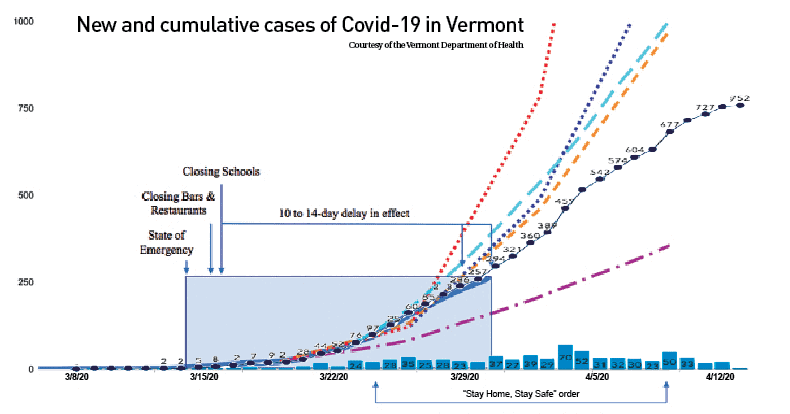
Governor Phil Scott gradually began reopening the state economy due to modeling mid-April that continued to show significantly slowing of new confirmed cases. The charts above show various earlier projections of case volume compared to the actual number reported . As you can see reality beat all but the very best case projection (shown in purple). The bar graph at the bottom shows new cases per day — evidence that Vermonters have been successful at “flattening the curve” here, at least thus far.
April 17, Governor Scott ordered the U.S. and Vermont flags to fly at half-mast the 19th of every month of 2020 to honor those Vermonters who died from Covid-19.
April 17, Governor Scott announced a phased restart of Vermont’s economy, where 1-2 people operations can open following strict safety and social distancing protocols.
April 14, Governor Scott announced the establishment of the State of Vermont Economic Mitigation & Recovery Task Force.
April 10, Governor Scott extended Vermont’s State of Emergency through May 15, which also extended the expiration of all other mitigation directives.
April 7, Governor Phil Scott requested federal disaster funds. April 8 the request was approved. (All 50 states were under a disaster declaration for first time in U.S. history.)
April 2, Governor Scott announced additional medical surge locations, expanding the state capacity by hundreds of beds including a surge location at Spartan Arena for Rutland Regional Medical Center adding 150 beds.
March 30, Governor Scott ordered residents and non-residents coming from outside the state for anything other than an essential purpose to home-quarantine for 14 days and strongly discouraged travel to Vermont by those located in Covid-19 “hot spots” designated by the CDC.
March 26, Governor Scott directed schools to remain dismissed for in-person instruction through the end of the 2019-2020 school year.
March 24, Governor Scott issued a “Stay Home, Stay Safe” order and directed the closure of in-person operations for all non-essential businesses (effective March 25-April 15).
March 23, Governor Scott ordered telecommuting or work from home procedures for all businesses and not-for-profit entities, to the maximum extent possible.
March 21, Governor Scott ordered the closure of close-contact businesses.
March 21, Governor Scott further restricted non-essential gatherings to 10 or less people.
March 20, Governor Scott ordered suspension of all non-essential adult elective surgery and medical surgical procedures.
March 19, Governor Scott authorized takeout and delivery of alcoholic beverages with food orders.
March 18, Governor Scott suspended in-person transactions at the Department of Motor Vehicles.
March 17, Governor Scott directed childcare centers to close.
March 16, Governor Scott ordered the closure of all bars and restaurants (takeout and delivery service are still permitted.)
March 16, Governor Scott restricted gatherings to 50 or less or 50% of occupancy of a facility.
March 15, Governor Scott directed the dismissal of Pre-K-12 schools.
March 13, Governor Scott restricted visitor access at long-term care facilities.
March 13, Governor Scott declared a State of Emergency.
March 13, Governor Scott restricted non-essential gatherings of more than 250 people in a single room or a single space; and prohibited all non-essential out-of-state travel by state employees.
March 7, the first case of Covid-19 was confirmed in Vermont.
For more information or to see current executive orders visit governor.vermont.gov.



